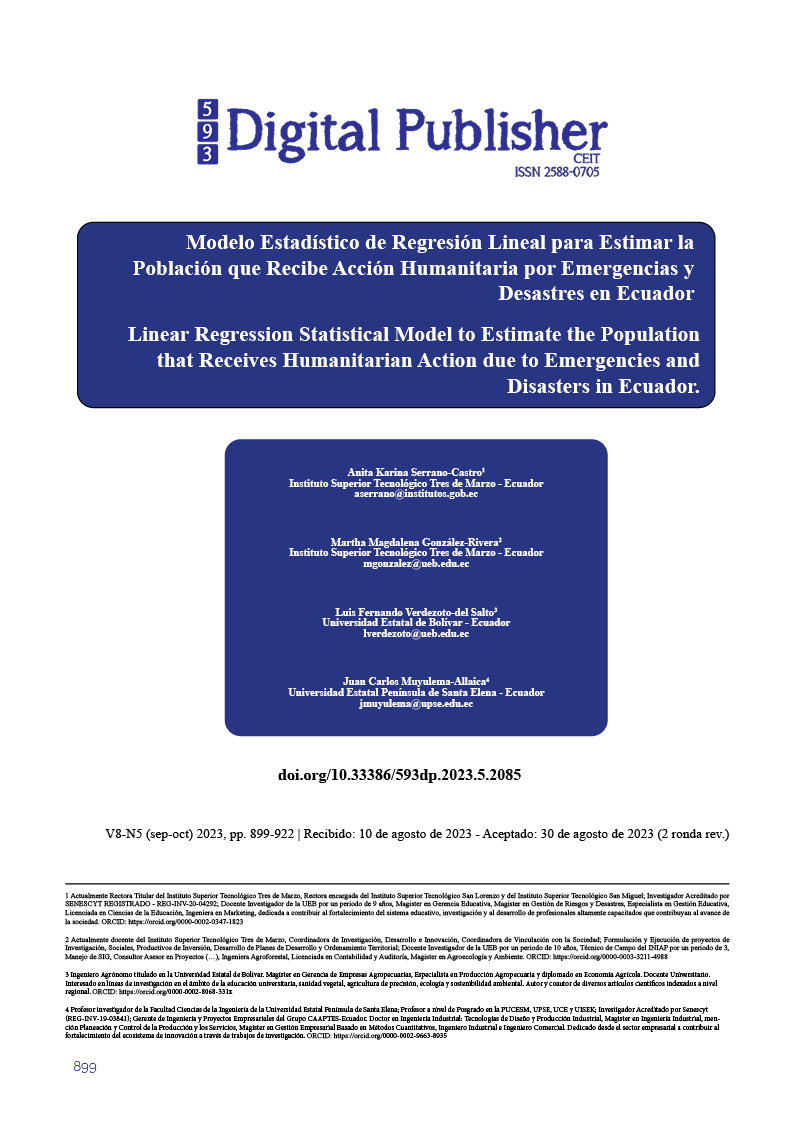Linear Regression Statistical Model to Estimate the Population that Receives Humanitarian Action due to Emergencies and Disasters in Ecuador.
Main Article Content
Abstract
The objective of this research work is to estimate, through a mathematical model, the population that received humanitarian aid due to the emergency or natural disasters that arose in the coastal and highland regions of Ecuador. The statistical model of multiple linear regression was applied, which considers seven explanatory variables: (1) affected population (2) affected population (3) affected houses (4) destroyed houses (5) hectares of affected crops (6) hectares of lost crops (7) probability of occurrence, with the following scheme
Y=β0+β1X1+β2X2+β3X3+β4X4+β5X5+β6X6+β7X7+ei
The work data correspond to 811 records in the period 2016 - 2020 and come from the reports of the National Risk Management System and the fire departments of Ecuador. Seven variables were considered, however, only three variables express validity, consistency and reliability of the parameters and are within the acceptance range. The results of the multiple linear regression model were: Y=36451+0.16X1+0.38X2+0.858X3+ei, from this statistical tool it is intended to predict future impacts due to emergencies or disasters in order to plan logistics and immediate assistance designed to save lives, alleviate suffering, maintain and protect human dignity, in prevention or in emergency situations and/or rehabilitation.
Downloads
Article Details

This work is licensed under a Creative Commons Attribution-NonCommercial-ShareAlike 4.0 International License.
1. Derechos de autor
Las obras que se publican en 593 Digital Publisher CEIT están sujetas a los siguientes términos:
1.1. 593 Digital Publisher CEIT, conserva los derechos patrimoniales (copyright) de las obras publicadas, favorece y permite la reutilización de las mismas bajo la licencia Licencia Creative Commons 4.0 de Reconocimiento-NoComercial-CompartirIgual 4.0, por lo cual se pueden copiar, usar, difundir, transmitir y exponer públicamente, siempre que:
1.1.a. Se cite la autoría y fuente original de su publicación (revista, editorial, URL).
1.1.b. No se usen para fines comerciales u onerosos.
1.1.c. Se mencione la existencia y especificaciones de esta licencia de uso.
References
Andina, C. (2018). Glosario de Términos. Servicio Nacional de Gestión de Riesgos, 28. Recuperado de: https://www.gestionderiesgos.gob.ec/wp-content/uploads/downloads/2019/01/GLOSARIO-DE-T%C3%89RMINOS-DE-GESTI%C3%93N-DE-RIESGOS-DE-DESASTRES-GUIA-DE-CONSULTA.pdf
BID. (2015). Indicadores de riesgo de desastre y de gestión de riesgos: Programa para América Latina y el Caribe: Argentina. En Indicadores de riesgo de desastre y de gestión de riesgos: Programa para América Latina y el Caribe: Argentina. https://doi.org/10.18235/0000203
Carrasco J.L., Hernán M. A. (2019). Estadística Multivalente en las Ciencias de la Salud. Madrid: Ediciones Díaz de Santos S.A.
Castorena, L. E. (2021). Modelo de Regresión para Estimar Datos Faltantes de Lluvia en la Región del Altiplano Zacatecano. Academia Journals 2021, 13(3), 414-454.
FAO. (2019). El estado mundial de la agricultura y la alimentación. Progresos en la lucha contra la pérdida y el desperdicio de alimentos. El Estado Del Mundo, 32(3).
Fei, W., Lu, D., & Li, Z. (2023). Research on the layout of urban disaster-prevention and risk-avoidance green space under the improvement of supply and demand match: The case study of the main urban area of Nanjing, China. Ecological Indicators, 154, 110657. https://doi.org/https://doi.org/10.1016/j.ecolind.2023.110657
Guerra, I. D. (2019). Regresión sobre componentes principales. Universidad de Sevilla. Recuperado de: https://idus.us.es/bitstream/handle/11441/90005/Deduy%20Guerra%20Irene%20TFG.pdf?sequence=1&isAllowed=y
Handbook, S. (2019). Humanitarian Charter and Minimum Standards in Humanitarian Response. Sphere Project.
Jiang, S., Li, J., Zhang, S., Gu, Q., Lu, C., & Liu, H. (2022). Landslide risk prediction by using GBRT algorithm: Application of artificial intelligence in disaster prevention of energy mining. Process Safety and Environmental Protection, 166, 384-392. https://doi.org/https://doi.org/10.1016/j.psep.2022.08.043
Luu, C., von Meding, J., & Mojtahedi, M. (2019). Analyzing Vietnam’s national disaster loss database for flood risk assessment using multiple linear regression-TOPSIS. International Journal of Disaster Risk Reduction, 40(April), 101153. https://doi.org/10.1016/j.ijdrr.2019.101153
Mendoza, Á. G. F., Mateos, M. R., & Reinoso, N. G. (2021). Perception and rating of tourism entrepreneurs in the recovery of travel destinations affected by social-natural disasters: Case study from the April 16th earthquake in Ecuador. International Journal of Disaster Risk Reduction, 64, 102488. https://doi.org/https://doi.org/10.1016/j.ijdrr.2021.102488
Montenegro-Canario, S. S., Iannacone, J., & Barrios, N. (2015). Modelo Estadístico para estimar la población que recibe ayuda humanitaria por desastres en el Perú. The Biologist (Lima), 13(2), 374-390. https://doi.org/10.24039/rtb20151321556
Montero, R. (2016). Modelos de regresión lineal múltiple. Modelos de regresión lineal múltiple.Documentos de Trabajo en Economía Aplicada. Universidad de Granada. España.
Navarrete, M. P. (2019). Herramientas de Software Aplicadas al Método de Regresión Lineal. Universidad de Colombia.
Programa de las Naciones Unidas para el Desarrollo. (2018). Plan Nacional para la Reducción de Riesgos de Desastres. SINAGIR.
Refugiados, Agencia de la (ONU). (2019). Ayuda humanitaria, la única forma de sobrevivir para millones de personas. Agencia de la ONU.
Resolución 46/182 de las Naciones Unidas. (1991). Fortalecimiento de la coordinación de la asistencia humanitaria de emergencia del sistema de las Naciones Unidas.
Rivera-Bermello, L. E., Rivera-Cedeño, G., & Laz-Argandoña, J. (2020). Derechos humanos y ayuda humanitaria desde el contexto latinoamericano. Revista Científica de Investigación Multidisciplinaria Arbitrada SCIENTIA, 2(4), 2-8. https://doi.org/10.46296/sc.v2i4.0008
Serrano-Castro, A. K., Muyulema-Allaica, J. C., Usca-Veloz, R. B., & González-Rivera, M. M. (2019). Aplicación de la metodología STAR para el análisis del riesgo sísmico de la provincia Bolívar – Ecuador. Ciencia Digital, 3(4), 227-249. https://doi.org/10.33262/cienciadigital.v3i4.968
Servicio Nacional de Gestión de Riesgos y Emergencias. (2020). RESOLUCIÓN Nro. SNGRE-034-2020. Quito.
Servicio Nacional de Gestión de Riesgos y Emergencias. (2022). informes de situación (SITREP). https://www.gestionderiesgos.gob.ec/informes-de-situacion-actual-por-eventos-adversos-ecuador/.
Servicio Nacional de Gestión de Riesgos. (2015). Normativa para aplicación de estándares de ayuda humanitaria en emergencia para alimentos, cocina, hogar y limpieza. Quito: https://reliefweb.int/sites/reliefweb.int/files/resources/Full_doc_32.pdf.
Shah, I., Elahi, N., Alam, A., Dawar, S., & Dogar, A. A. (2020). Institutional arrangement for disaster risk management: Evidence from Pakistan. International Journal of Disaster Risk Reduction, 51, 101784. https://doi.org/https://doi.org/10.1016/j.ijdrr.2020.101784
Toulkeridis, T. (2015). Amenazas de origen natural y gestión de riesgo en el Ecuador. Sangolquí: Universidad de las Fuerzas Armadas ESPE.
Verdezoto-Mendoza, F. P., Muyulema-Allaica, J. C., Serrano-Castro, K. A., & Verdezoto-del-Salto, L. F. (2021). Evaluación de la variabilidad climática en el cantón Chillanes mediante los parámetros de la precipitación y la temperatura. Alfa Publicaciones, 3(4.1), 70-84. https://doi.org/https://doi.org/10.33262/ap.v3i4.106
Weisberg, S. (2018). Applied Linear Regression. John Wiley & Sons.
Zhou, L., Perera, S., Jayawickrama, J., & Adeniyi, O. (2014). The Implication of Hyogo Framework for Action for Disaster Resilience Education. Procedia Economics and Finance, 18, 576-583. https://doi.org/https://doi.org/10.1016/S2212-5671(14)00978-2





